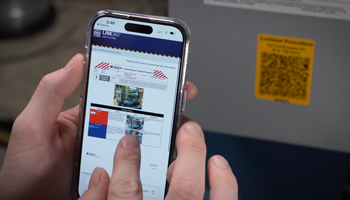Labels for Safety, Visuals and Facility ID Desktop Printers
Labels for Product, Wire and Lab ID Benchtop Printers
Labels for Safety, Visuals and Facility ID Desktop Printers
Labels for Product, Wire and Lab ID Benchtop Printers
Safety and Facility ID Desktop Printers
Product, Wire & Lab ID Desktop Printers
Pipe Marker Accessories & Mounting Brackets
Valve Lockouts & Hose Lockouts
Group Lock Boxes & Permit Control
PaintStripe Floor Marking Stencils
Maintenance and Production Tags
Calculators and Assessment Tools
Product Finders and Data Sheets
Effective lockout tagout (LOTO) procedures are essential for safeguarding workers during equipment maintenance and servicing. But outdated methods like spreadsheets and paper-based processes can leave workers vulnerable and organizations exposed to unnecessary risk.
Investing in modern LOTO software is a game-changer. But getting management to approve the investment can sometimes be challenging. This guide equips you with a detailed roadmap to build the case and secure the resources you need to add or upgrade software as part of your complete, OSHA-compliant lockout tagout program.
Lockout tagout procedures are critical for preventing injuries and fatalities during equipment maintenance and servicing. They ensure that energy sources are properly isolated, prevent accidental equipment start-up and protect workers from harm. When these critical procedures are left to manual or outdated processes, it can lead to:
LOTO software addresses these challenges by centralizing procedures, automating updates, simplifying compliance and enhancing visibility.

Follow these steps to make the case to management for the need to invest in LOTO software.
To help management truly understand the need for LOTO software, start by quantifying the potential risks and costs associated with inadequate lockout tagout procedures. OSHA estimates that employers pay almost $1 billion per week for direct workers' compensation costs alone.¹ But then there are the hidden costs of non-compliance: production delays, damaged reputation and lowered employee morale. Audit your program, analyze near-miss incidents and identify safety or procedural gaps to reveal potential weaknesses and emphasize the urgency for improvement. You know your business and industry best, so present numbers that are specific to your challenges.

LOTO software offers significant benefits over traditional and manual processes.
Emphasize how the software reduces human error, improves communication, and fosters a stronger safety culture. This can lead to a significant reduction in workplace injuries and fatalities.
Demonstrate how streamlined procedures and automated updates save time and resources. Workers can access the latest procedures quickly and easily, reducing downtime and improving productivity.
Showcase how the software simplifies audits and ensures adherence to regulations. This reduces the risk of fines and legal issues.
Explain how targeted shutdowns and faster restarts minimize production interruptions. By isolating only the necessary equipment, LOTO software can help prevent unnecessary downtime and keep operations running smoothly.
Investing in LOTO software offers a compelling return on investment by generating significant cost savings across various areas. Software platforms reduce the need for extensive training, leading to immediate savings in both time and money. LOTO software also minimizes costly downtime by streamlining lockout procedures and shutdowns. Unplanned downtime can cost industrial facilities as much as $260,000 per hour.2 So even small reductions in production losses can translate to substantial financial gains, quickly offsetting the initial investment. Furthermore, improved compliance achieved through the software helps avoid OSHA fines, which can range from $15,625 for serious violations to $156,259 for willful or repeated violations.3 Speaking of OSHA, the organization offers their Safety Pays tool, to help demonstrate the financial and safety implications of inadequate LOTO, and build a strong case for investing in a solution that mitigates these risks.
While every organization has unique goals, LOTO software can be a valuable asset in achieving them, including the following strategic focus areas.
Position LOTO software as a key component of a proactive safety culture. A strong safety culture can improve employee morale, reduce turnover and enhance your company's reputation.
Emphasize how the software contributes to efficiency and productivity, which are essential for achieving business goals.
Highlight the software's ability to track data and identify safety gaps as well as areas for improvement, enabling data-driven decision-making.

To best make the case to management and secure buy-in for your LOTO software, it's crucial to present a well-researched and comprehensive plan. Begin by thoroughly researching different LOTO software solutions, carefully comparing features, benefits and pricing structures to identify the option that best aligns with your organization's specific needs and budget. Once you've selected your preferred software, outline a clear and detailed implementation plan. This plan should include realistic timelines, required resources, potential challenges and mitigation strategies. Finally, to demonstrate the value of your proposal, conduct a thorough cost-benefit analysis that highlights the financial advantages of investing in LOTO software.
By presenting a polished and professional proposal that showcases the software's potential to improve safety, efficiency and compliance, you'll significantly increase your chances of securing management approval and driving meaningful improvements within your organization.


When it comes to selecting the right LOTO software for your organization, Brady stands out as a leader in providing comprehensive, intuitive and effective solutions.
LINK360® Safety Software is a powerful cloud-based platform that empowers organizations to create and manage their LOTO procedures with ease. Its intuitive interface allows users to develop visual lockout procedures, complete with detailed steps and images, ensuring clarity and consistency across the organization. LINK360 also simplifies the process of employee training, tracking updates and generating reports, providing valuable insights into safety performance.
For organizations seeking even greater control and customization, Brady offers LINK360 Process Plus. dynamic lockout procedure management for process industries. This best-in-class lockout tagout software builds upon the core functionalities of LINK360 with advanced features such as dynamic isolation point database, visual procedure creation for complex systems, automatic updates and seamless integration for tagging and labeling.
Talk to a Brady expert today to learn more about which LOTO software solution is right for you.

Outsmart complexity and outpace downtime with LINK360® Process Plus Safety Software from Brady – dynamic lockout procedure management for process industries.
Optimize Safety with LINK360® Process Plus
Effectively manage and sustain your safety program with the LINK360® Lockout Procedure Bundle. Create up to 1,000 unique procedures for lockout tagout, confined space and maintenance programs.
Streamline Your Safety Procedures
Safety label printers from Brady help you create effective ANSI-compliant visuals, including Danger, Warning, Caution and Notice signs and labels.
Create Compliant Safety Labels
In the realm of workplace safety, lockout tagout (LOTO) is a cornerstone in protecting workers from machinery risks and requires a comprehensive program to be adapted.
View the Lockout Tagout Tryout Guide
A typical lockout tagout program can contain over 80 elements. Read on to better understand the 6 key elements that go into a successful lockout tagout program.
Learn OSHA Compliant LOTO
Lockout tagout is the de-energizing and securing of equipment, machinery or processes so hazardous energy isn’t re-introduced during servicing or repair. This simple lockout tagout definition only scratches the surface.
Understand Lockout Tagout